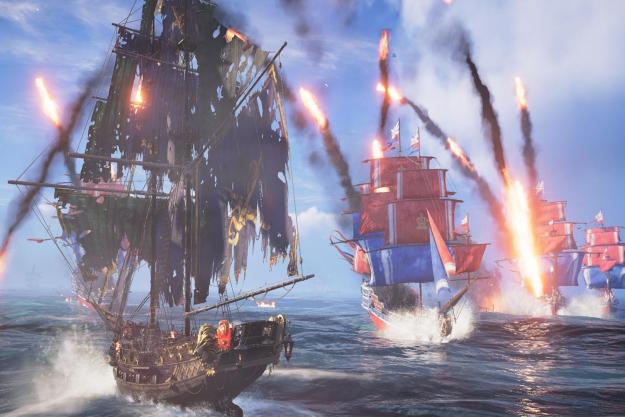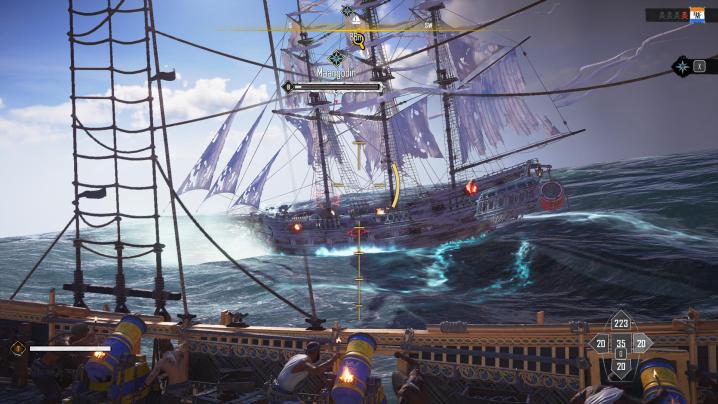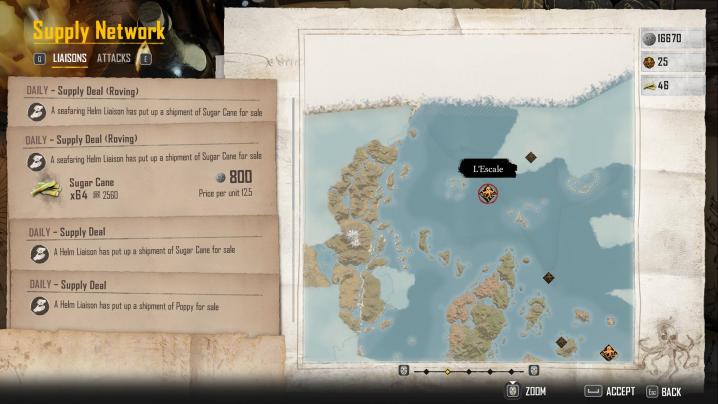
“Skull and Bones turns the Golden Age of Piracy, one of the most exciting periods in history, into a mundane and plodding experience.”
- Exciting naval combat
- Good variety of ships
- Top-notch visuals and performance
- Mundane tasks
- Mechanics don’t feel fully fleshed out
- Uncompelling late-game activities
- Weak narrative and characters
Skull and Bones is Ubisoft’s long-awaited massively multiplayer online (MMO), open-world adventure game set during the Golden Age of Piracy. “Long-awaited” is an understatement, given that it’s been delayed numerous times throughout its decade-long development cycle. Now, we’re finally in the homestretch, past its conceptualization as a follow-up to Assassin’s Creed IV: Black Flag and numerous changes,
Touted by Ubisoft CEO Yves Guillemot as a “quadruple-A title” and with a dozen studios appearing in the opening credits, Skull and Bones’ maiden voyage has all the pomp that you can imagine. Yet,this journey may as well be its last. After playing the Skull and Bones open beta and the launch build, I can say that this might be one of the most disappointing major releases in recent memory.
That’s not to say that the long-delayed Skull and Bones is a disaster. Naval battles are thrilling, and it’s a visual spectacle with standout ship designs, settlements, and visual effects that are masterfully rendered to create a cinematic experience. Everything else, though, comes with a caveat. A slew of questionable design decisions sink what could have been a great pirate game into another weak live-service game in a sea full of them.
Lords of the high seas
Skull and Bones’ story begins when my ship is sunk by a hostile fleet. Landless (and rudderless), I’m told of Sainte-Anne, a pirate haven where I can start anew. It’s there where I meet John Scurlock, the kingpin of Sainte-Anne. It’s a fun concept, but one Skull and Bones doesn’t capitalize on. Instead, it fumbles the idea of an adventure game set during the Golden Age of Piracy. The core gameplay loop consists of obtaining quests from Scurlock and other NPCs, collecting crafting materials for ships and weapons, and roaming around while trying to sink naval craft along the way.
Havens and settlements merely act as places where I buy stuff or pick up quests. There’s no system where I can recruit crewmates or search for talented officers (i.e., quartermaster, cook, or boatswain). The process of gathering resources, meanwhile, is relegated to a minigame where I click on the mouse when it’s in the “green zone” of the meter.

Barring Scurlock and a few others, most NPCs are just vendors or quest givers that are completely devoid of personality. Combine these with a threadbare narrative that hardly gets off the ground, and the premise of being a swashbuckling hero falls flat rather abruptly. I felt no connection at all to my character. I wasn’t playing as a pirate; I was playing as a pirate ship.
Buccaneers and boom shots
Though its story is lacking, Skull and Bones offers a true cinematic experience with its thrilling naval engagements. While aboard my vessel, I’d hunt down AI-controlled ships by lowering the sails to catch the wind, gradually depleting my crew’s stamina in the process. I’d fire off long-distance shots, then perform tight turns for broadside volleys, before arming torpedoes from my ship’s stern. Ship controls are smooth, responsive, and easy enough to get used to. Item usage, like repair kits to restore my hull’s hit points or cooked food to replenish the crew’s stamina, require just a quick action wheel button press.
Chasing down a target across stormy seas is as exhilarating as you can imagine.
The strong battle loop is further helped by a variety of ship options. All players start out with the Dhow, a small craft that’s mostly used to hunt for sharks and other animals, before obtaining the Bedar. From there, it’s up to you to amass resources and gain Infamy (akin to experience points) by completing quests and sinking enemies. Infamy rank-ups then unlock additional ship and weapon blueprints that you can purchase from NPCs.
Mid- to late-game options include the explosive specialist Padewakang and speedy Brigantine (both of which are my go-to picks), as well as the tank-like Snow and fire attack-focused Sambuk. There are a wealth of armaments to choose from, too, allowing players to mix and match weapons for their ship’s loadout. I can shoot foes from afar with long guns or ballistae, deal area-of-effect (AoE) damage with bombards and mortars, or ram straight into hostiles before torching them with sea fires.

Still, even if naval combat is Skull and Bones’ one true highlight, there were a few key problems. The most obvious is that boarding actions are just quick cutscenes and there’s no melee combat — something that Assassin’s Creed IV: Black Flag offered a toon of a decade ago. Many enemies don’t have survival instincts either, as they’d continue aggressively attacking even with low hull health. There were also moments when ship AI stopped working properly, such as when I faced the Maangodin, a ghost ship that’s hidden in the mists. I expected an epic fight, only for the Maangodin to spin around in place without shooting me.
The opposite can be said of mercenaries from the Rogues faction, which spawn whenever there are players that are undertaking late-game Helm supply runs (more on these later). These opponents attack all players, so it’s possible to see some of them gunning down hapless newcomers who are just about to leave the Sainte-Anne hub.
The captain’s checklist
The world of Skull and Bones might be vast, but its objectives are as mundane as can be. That’s primarily due to a tally- or checklist-style approach. Early on, I’m loaded up with quests to destroy X number of ships or collect Y amount of resources. That’s a fine loop, but one that repeats itself. When I head to another island, I realize that my tasks are similar, but with different types of ships or resources. It’s also possible for the same exact objective to reappear a few hours later, whether from the same vendor NPC or a new one.

Even searching for buried treasure somehow becomes a forgettable task. It entails sailing to a location, checking an illustration for an object that has a symbol, and looking for a glowing light that lets you dig for the chest. There are no peculiar mysteries or intricate riddles involved.
The adventure is predominantly set in the Indian Ocean, where several factions vie for control. Though, curiously enough, there’s no way to work for these factions (i.e., no built-in reputation system or mission list). I think back to Sid Meier’s Pirates!, which allowed me to become a privateer for rival nations, going so far as to claim settlements on their behalf. That’s a remake released in 2004, and yet its own systems felt more fleshed out than what’s explored here.
It seems that my cats have an even better memory than the ocean’s greatest pirates.
At best, you can ransack and plunder the settlements of other factions in Skull and Bones. That activity gets tedious too, as it follows a repetitive process where I just destroy cannons and sink a handful of ships that come in waves. If just a few seconds elapse, the factions turn neutral again, as though they completely forgot the atrocities that I’ve just committed. It seems that my cats have an even better memory than the ocean’s greatest pirates.
The Kingpin’s trading empire
I especially began to disconnect from Skull and Bones’ campaign as a whole when it introduced its endgame activities: the Helm Empire. This acts as the long-term engagement loop, where you collect and deliver illicit cargo such as alcohol and drugs. The quest chain itself triggers independently of Scurlock’s arc. The goals are to complete more supply runs, eliminate ships from the Rogues faction along the way, and earn Pieces of Eight currency used for seasonal upgrades and items.
When I tried to go it alone, I was at a disadvantage.
There are also world events that function as PvPvE activities, like Legendary Heists where you take out a “cannon sponge” target, and the person who dealt the most damage tries to escape with the reward. Naturally, those not in that player’s group would do their best to chase them down. Similarly, there are Hostile Takeovers, where squadrons attempt to capture factories that passively grant Pieces of Eight.
Skull and Bones’ PvPvE endgame offers very little to keep solo players engaged for longer periods. I tried out some of these activities, but they feel better suited for two- or three-player co-op. Settlement and ship objectives are extremely tough to solo, and it’s possible to encounter small co-op groups protecting one another during heists. When I tried to go it alone, I was at a disadvantage. My only recourse was to stick to the supply runs, and those tasks became monotonous after having already spent the majority of the campaign doing the same things over and over.

After playing Skull and Bones for 20 or so hours, I’ve found that there are some thrills to be had on the high seas. Naval battles certainly left me awestruck; ships explode in a glorious spectacle if you hit their weak spots, and the feeling of chasing down a target across stormy seas is as exhilarating as you can imagine. Performance with my PC hardware — an Nvidia RTX 3080, Intel i9-10900K, and 32 GB of RAM — was also top-notch, as I was able to play at the highest settings with hardly any egregious frame rate drops or stutters. Regrettably, Skull and Bones’ dull story, tedious quest objectives, questionable design decisions, and a poorly tuned experience for solo players made me furl the sails and return to shore as a landlubber.
Skull and Bones was reviewed on PC. The code was provided by the publisher.
Editors' Recommendations
- Is Skull and Bones crossplay?
- Skull and Bones: release date speculation, trailers, gameplay, and more
- Ubisoft and more offer ways to play purchased Google Stadia games elsewhere
- Ubisoft Forward September 2022: How to watch, what to expect
- Skull and Bones launches this fall, four years after its original release window




